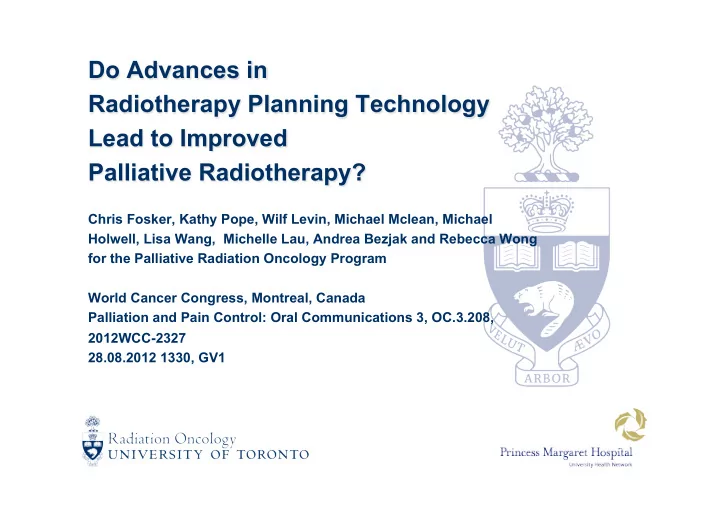

Do Advances in Radiotherapy Planning Technology Lead to Improved Palliative Radiotherapy? Chris Fosker, Kathy Pope, Wilf Levin, Michael Mclean, Michael Holwell, Lisa Wang, Michelle Lau, Andrea Bezjak and Rebecca Wong for the Palliative Radiation Oncology Program World Cancer Congress, Montreal, Canada Palliation and Pain Control: Oral Communications 3, OC.3.208, 2012WCC-2327 28.08.2012 1330, GV1
Background • Technology has revolutionize radiation oncology • Palliative patients - requiring simple (1-2) beam arrangements • 3D planning improves target delineation • Clinical outcomes? The role of CT simulation in WBRT. Gripp et al, IJROBP 1999; 45 (4):1081-1088 The impact of virtual simulation in palliative RT for NSCLC. McJury et al, R&O 2001; 59 (3): 311-318 CT simulation compared with clinical mark-up in palliative radiotherapy: a prospective study. Haddad et al, IJROBP 2006; 65 (3): 824-829 A dosimetric comparison of different treatment plans for spine RT. Andic et al, JECCR 2009; 28: 2 2
Objectives Evaluate the impact of different planning approach (3D) CT simulation vs. (2D) Digital radiograph based in palliative RT for bone metastases - Dosimetry - Decision making - Clinical outcome 3
Schema prospective cohort design Historical cohort Study cohort Diagnostic images Diagnostic images reviewed Document Intended target 2D field definition 2D field defined (DRR) using DRR 2D study plan 3D CT sim images Target definition 3D study plan Patient treated Clinical outcomes Clinical outcomes evaluated evaluated @ wk 1, 3 @ wk 1, 3, 6 4
Inclusion Criteria • Bone metastasis requiring palliative RT • Pain present • Suitable for simple beam arrangements • Able to express symptom score • Available for telephone follow up 5
Outcomes § Changes in target volume § Any change § Clinically significant change (post hoc) § >1 vertebral body change § >3 cm difference § Significant shielding change to shield normal structure(s) § Factors predictive of change § Site treated § Presence of soft tissue disease § Availability of diagnostic 3D imaging (CT/MRI) § Time between diagnostic 3D imaging and planning § Radiotherapy dose being delivered to target and normal structures § V 95 , PTV coverage, I MIN , HT over-dosage § Symptom response § Pain reduction at wk 3 § Fatigue, appetite, nausea symptom change at wk 3 6 § 0-10 scale
Results Study group: 92 sites (81 patients) 7
Impact of decision-making • Any change 52% (48/92) • Clinically significant change 27% (25/92) • Reason for change – Unsuspected local disease 88% (42/48) 8
Factors predictive of change Presence of soft tissue disease p = 0.02 Time gap from 3D diagnostic imaging to RT planning p = 0.09 Treated site p = 0.81 3D imaging availability p = 0.25 9
Dosimetric impact Mean 3D plans 2D plans p-value Volume receiving prescribed 1250cc 3 (±1061) 1557cc 3 (±1484) p<0.01 dose (V95) % target receiving prescribed 92.9% (±11.8) 73.6% (±23.4) p<0.01 dose (ideal = 100%, accept > 90%) Minimum dose to target 84.0% (±14.1) 40.2% (±33.1) p<0.01 Proportion of normal tissues 2.5 (±2.2) 4.1 (±8.6) p=0.04 receiving high dose (adjusted) (ideal = 0) 10
Patient reported outcomes Historical Study 3D 2D treated treated Pain score Anorexia score 2 1 Change score from baseline Change score from baseline 1 + Worse p=0.32 p=0.396 0.6 0 Wk 0 Wk 1 Wk 3 Wk 6 Historical cohort (2D) -1 0.2 Study cohort (3D) -2 Wk 0 Wk 1 Wk 3 Wk 6 -0.2 -3 -0.6 -4 Time after RT Time after RT Fatigue score Nausea score 2 - Improve 1 Change score from baseline 1 Change score from baseline 0.6 0 Wk 0 Wk 1 Wk 3 Wk 6 p=0.045 p=0.013 0.2 -1 Wk 0 Wk 1 Wk 3 Wk 6 -0.2 -2 11 -0.6 -3 Time after RT Time after RT
Conclusions 3D planning resulted in 52% of cases being changed; 27% clinically significant changes 3D planning leads to • smaller volumes irradiated to high doses • superior planning target coverage • improved healthy tissue sparing Patients with soft tissue disease and “ dated ” diagnostic imaging are most likely to benefit from 3D planning 12
Conclusions • We were unable to demonstrate a superior clinical outcome in 3D planned patients (historical controls) • Only randomized trial(s) would establish the impact of 3D planning on patient outcomes • Best way of leveraging technology (complexity) for the benefit of patients requiring palliative RT 13
Recommend
More recommend